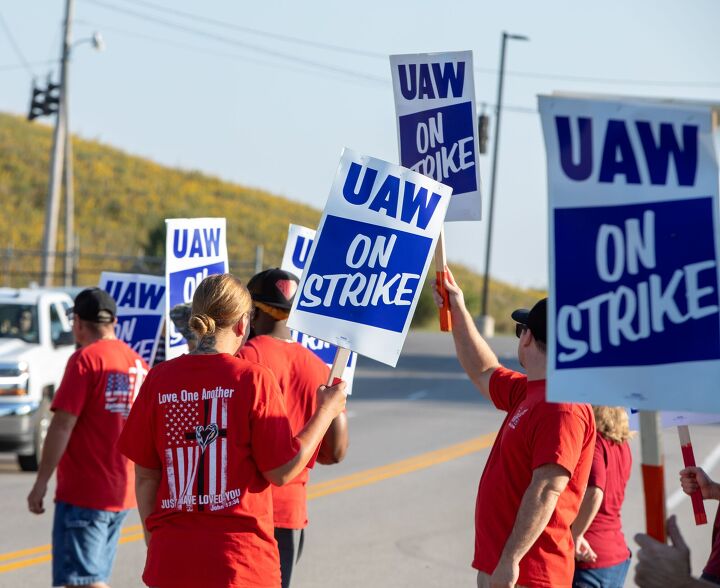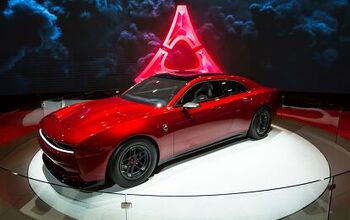UAW Strike Expands

The United Automobile Workers union has expanded its strike.
The strike started with three plants -- one for Ford, one for General Motors, and one for Stellantis -- and now the UAW is walking off the job at 38 parts-distribution plants for GM and Stellantis. Ford is being spared, as the union believes it is making more progress in its talks with the Blue Oval.
“We will shut down parts distribution centers until those two companies come to their senses and come to the bargaining table,” union president Shawn Fain was quoted as saying by The New York Times.
Breaking it down by the numbers, the walk-offs will affect 18 GM and 20 Stellantis plants. The GM distribution centers employ 3,475 workers and the Stellantis facilities have 2,150. All told, about 18,000 autoworkers are now on strike.
Fain told the Times that they union isn't "done" with Ford -- meaning no deal has yet been reached with the company -- but also that Ford seemed "serious" about reaching an agreement.
Fain also invited President Joe Biden to join the striking workers on the picket line. Biden has spoken in support of the workers. Meanwhile, former President Donald Trump, who is running to be elected president again, plans to visit with workers. Typically, the UAW throws its support behind the Democratic party, but it has yet to endorse a candidate for the 2024 election -- in part because of the Biden administration's push to increase the amount of electric vehicles on the market. One of the reasons the UAW is striking is that electric vehicles require fewer people to assemble -- so the UAW is trying to get concessions from automakers in case of a potential shrinking of the workforce.
The leak of internal Twitter, now X, messages from the UAW's PR chief to Fain that suggested glee on the part of the UAW if OEMs were harmed in terms of reputation or operations probably aren't helping to defuse tensions between the sides, though we'd note that of course the union would want to hurt the OEMs if it felt doing so would help its cause. Still, General Motors put out a statement decrying the content of the messages.
The expanded strike could have a ripple affect that would force other plants owned by automakers and suppliers to shutter.
The initial struck plants were a Ford plant in Michigan that produces the Bronco, a GM truck plant in Missouri, and the Jeep plant in Toledo, Ohio.
The union wants higher wages -- it asked for 40 percent before backing down to 36, while automakers are offering 20. Other demands from the union include a return to pensions and cost-of-living adjustments as well as the elimination of wage tiers.
Finally, the UAW would like fewer working hours (perhaps down to a four-day work week), healthcare plans for retirees that are paid for by the automakers, and a safety net -- along with the right to strike -- for workers who might lose their jobs if a plant closes. They also want to see limits on the use of temp workers.
[Image: TravelEatShoot/Shutterstock.com]
Become a TTAC insider. Get the latest news, features, TTAC takes, and everything else that gets to the truth about cars first by subscribing to our newsletter.

Tim Healey grew up around the auto-parts business and has always had a love for cars — his parents joke his first word was “‘Vette”. Despite this, he wanted to pursue a career in sports writing but he ended up falling semi-accidentally into the automotive-journalism industry, first at Consumer Guide Automotive and later at Web2Carz.com. He also worked as an industry analyst at Mintel Group and freelanced for About.com, CarFax, Vehix.com, High Gear Media, Torque News, FutureCar.com, Cars.com, among others, and of course Vertical Scope sites such as AutoGuide.com, Off-Road.com, and HybridCars.com. He’s an urbanite and as such, doesn’t need a daily driver, but if he had one, it would be compact, sporty, and have a manual transmission.
More by Tim Healey
Latest Car Reviews
Read moreLatest Product Reviews
Read moreRecent Comments
- Stan Reither Jr. Part throttle efficiency was mentioned earlier in a postThis type of reciprocating engine opens the door to achieve(slightly) variable stroke which would provide variable mechanical compression ratio adjustments for high vacuum (light load) or boost(power) conditions IMO
- Joe65688619 Keep in mind some of these suppliers are not just supplying parts, but assembled components (easy example is transmissions). But there are far more, and the more they are electronically connected and integrated with rest of the platform the more complex to design, engineer, and manufacture. Most contract manufacturers don't make a lot of money in the design and engineering space because their customers to that. Commodity components can be sourced anywhere, but there are only a handful of contract manufacturers (usually diversified companies that build all kinds of stuff for other brands) can engineer and build the more complex components, especially with electronics. Every single new car I've purchased in the last few years has had some sort of electronic component issue: Infinti (battery drain caused by software bug and poorly grounded wires), Acura (radio hiss, pops, burps, dash and infotainment screens occasionally throw errors and the ignition must be killed to reboot them, voice nav, whether using the car's system or CarPlay can't seem to make up its mind as to which speakers to use and how loud, even using the same app on the same trip - I almost jumped in my seat once), GMC drivetrain EMF causing a whine in the speakers that even when "off" that phased with engine RPM), Nissan (didn't have issues until 120K miles, but occassionally blew fuses for interior components - likely not a manufacturing defect other than a short developed somewhere, but on a high-mileage car that was mechanically sound was too expensive to fix (a lot of trial and error and tracing connections = labor costs). What I suspect will happen is that only the largest commodity suppliers that can really leverage their supply chain will remain, and for the more complex components (think bumper assemblies or the electronics for them supporting all kinds of sensors) will likley consolidate to a handful of manufacturers who may eventually specialize in what they produce. This is part of the reason why seemingly minor crashes cost so much - an auto brand does nst have the parts on hand to replace an integrated sensor , nor the expertice as they never built them, but bought them). And their suppliers, in attempt to cut costs, build them in way that is cheap to manufacture (not necessarily poorly bulit) but difficult to replace without swapping entire assemblies or units).I've love to see an article on repair costs and how those are impacting insurance rates. You almost need gap insurance now because of how quickly cars depreciate yet remain expensive to fix (orders more to originally build, in some cases). No way I would buy a CyberTruck - don't want one, but if I did, this would stop me. And it's not just EVs.
- Joe65688619 I agree there should be more sedans, but recognize the trend. There's still a market for performance oriented-drivers. IMHO a low budget sedan will always be outsold by a low budget SUV. But a sports sedan, or a well executed mid-level sedan (the Accord and Camry) work. Smaller market for large sedans except I think for an older population. What I'm hoping to see is some consolidation across brands - the TLX for example is not selling well, but if it was offered only in the up-level configurations it would not be competing with it's Honda sibling. I know that makes the market smaller and niche, but that was the original purpose of the "luxury" brands - badge-engineering an existing platform at a relatively lower cost than a different car and sell it with a higher margin for buyers willing and able to pay for them. Also creates some "brand cachet." But smart buyers know that simple badging and slightly better interiors are usually not worth the cost. Put the innovative tech in the higher-end brands first, differentiate they drivetrain so it's "better" (the RDX sells well for Acura, same motor and tranmission, added turbo which makes a notable difference compared to the CRV). The sedan in many Western European countries is the "family car" as opposed to micro and compact crossovers (which still sell big, but can usually seat no more than a compact sedan).
- Jonathan IMO the hatchback sedans like the Audi A5 Sportback, the Kia Stinger, and the already gone Buick Sportback are the answer to SUVs. The A5 and the AWD version of the Stinger being the better overall option IMO. I drive the A5, and love the depth and size of the trunk space as well as the low lift over. I've yet to find anything I need to carry that I can't, although I admit I don't carry things like drywall, building materials, etc. However, add in the fun to drive handling characteristics, there's almost no SUV that compares.
- C-b65792653 I'm starting to wonder about Elon....again!!I see a parallel with Henry Ford who was the wealthiest industrialist at one time. Henry went off on a tangent with the peace ship for WWI, Ford TriMotor, invasive social engineering, etc. Once the economy went bad, the focus fell back to cars. Elon became one of the wealthiest industrialist in the 21st century. Then he went off with the space venture, boring holes in the ground venture, "X" (formerly Twitter), etc, etc, etc. Once Tesla hit a plateau and he realized his EVs were a commodity, he too is focused on his primary money making machine. Yet, I feel Elon is over reacting. Down sizing is the nature of the beast in the auto industry; you can't get around that. But hacking the Super Charger division is like cutting off your own leg. IIRC, GM and Ford were scheduled to sign on to the exclusive Tesla charging format. That would have doubled or tripled his charging opportunity. I wonder what those at the Renaissance Center and the Glass House are thinking now. As alluded to, there's blood in the water and other charging companies will fill the void. I believe other nations have standardized EV charging (EU & China). Elon had the chance to have his charging system as the default in North America. Now, he's dropped the ball. He's lost considerable influence on what the standardized format will eventually be. Tremendous opportunity lost. 🚗🚗🚗


































Comments
Join the conversation
@El scotto , I'm aware of the history, I have been in the "working world" for close to 40 years with many of them being in automotive. We have to look at situation in the "big picture". Did UAW make concessions in past ? - yes. Do they deserve an increase now ? -yes . Is their pay increase reasonable given their current compensation package ? Not at all ! By the way - are the automotive CEO's overpaid - definitely! (That is the case in many industries, and a separate topic). As the auto industry slowly but surely moves to EV's , the "big 3" will need to be producing top quality competitive vehicles or they will not survive.
Canadian auto workers (UNIFOR) ratified a new deal with Ford. 3 years. 10% wage increase this year, and 2% in year two, and 3% in year three. Plus a cost of living allowance (COLA) and a $10,000 signing bonus per worker. Monthly pension raised to $3,795 after 30 years of service. Hourly wage of $46.13 at the end of the contract for assembly workers.
UNIFOR will now use this when negotiating with GM and Stellantis.
How will the UAW contract stack up.
https://www.unifor.org/news/all-news/unifor-members-ratify-collective-agreement-ford-motor-company